Physical Address
304 North Cardinal St.
Dorchester Center, MA 02124
Placenta praevia and placenta accreta are a source of maternal and fetal morbidity and mortality. They are associated with increasing healthcare costs. Their incidence is rising as the number of Caesarean sections and maternal age increase. The importance of these conditions is reflected by the provision of management guidelines by the Royal College of Obstetricians and Gynaecologists.
The human placenta has a discoid shape with a diameter of 20–25 cm at term with a birth weight of about 500 g. The placenta is derived from maternal decidua and fetal chorionic villi. The placenta and the chorionic membranes have the same origin. The early chorion surrounding the gestation sac has chorionic villi all around it. Trophoblast associated with the capsular decidua becomes atrophied, probably due to nutritional deficiency, to form the chorion laeve, whereas the trophoblast in contact with the basal decidua proliferates to form the chorion frondosum. Chorion laeve becomes the chorionic membrane and the chorion frondosum becomes the placenta. Inevitably these two structures are always joined, with the chorionic membrane leading to the edge of the placenta. The site of placental formation can often be seen with transvaginal ultrasound from 8 weeks menstrual age, but more commonly it is only discernable after 9 weeks ( Figure 5-1 ). The polarization of the chorion into chorionic membrane and placenta usually appears complete on ultrasound by 12 weeks, but may not be pathologically so until 17 weeks. The normal placenta grows in a uniform fashion provided the vascular supply and oxygen delivery system are intact. In general, the placental thickness in millimetres is equivalent to the gestational age in menstrual weeks.
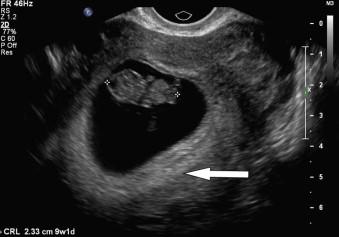
Placental grading is based on the original work by Grannum et al. Whilst the original premise that placental calcification predicts lung maturity has been discounted, there has been renewed interest in how placental architecture might influence pregnancy.
For instance it has been suggested that:
Placental calcification is associated with an increase in intrauterine growth retardation.
Placental lakes are more prevalent in those with threatened miscarriage.
Increased placental thickness is associated with a higher rate of fetal acidosis.
A lateral placental position is commoner in growth retardation.
Smoking in pregnancy is associated with premature placental calcification.
There are multiple causes of hypo-echoic lesions within the placenta which are usually very easy to see but harder to explain in terms of impact if any on pregnancy outcome. These lesions include: subchorionic fibrin deposition, intervillous thrombosis, perivillous fibrin deposition, anechoic hypo-echoic lakes and septal cysts. All present as hypo-echoic lesions in the placental substance; the only differentiating features are detailed below. The significance of these lesions has to be evaluated in the clinical setting and obviously the management is the management of the fetal problem not the placental lesion!
These are plaques of laminated fibrin in the placenta; they can appear as early as 12 weeks and then gradually decrease in size. Occasionally slow flow may be visible within, but they are of no clinical significance.
This is thrombosis in the intervillous space due to fetal haemorrhage and may be seen in up to 40% of uncomplicated term placentas; once again they are not considered clinically significant.
As a consequence of pooling of blood in the intervillous space, perivillous fibrin deposition results. Once again this will be found in 25% of uncomplicated term placentas and has no clinical significance. This lesion may have an echogenic rim on ultrasound.
These lesions probably represent a stage in the evolution of either perivillous fibrin deposition or intervillous thrombosis; they are not uncommon and occasionally flow is seen within ( Figure 5-2 ).
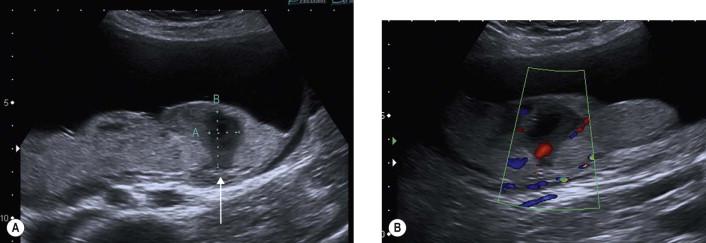
These are simply cysts, seen in up to 19% of uncomplicated pregnancies, that have no significance.
A velamentous cord insertion describes the insertion of the umbilical cord into the membranes at the placental margins rather than directly as normal onto the placental surface. Its importance lies in the association with vasa praevia and the risk of severe fetal haemorrhage in labour ( Figure 5-3 ).
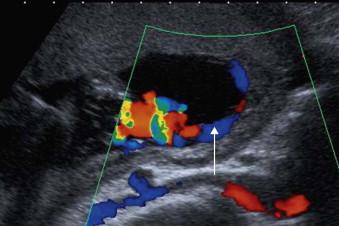
Bilobed or multilobed placentas of roughly equal parts occur in up to 4% of pregnancies and the placental lobes may be linked by a thin bridge of chorionic tissue. Once again their significance lies in the association with velamentous cord insertions.
A succenturiate lobe is an accessory lobe, usually a relatively small amount of placental tissue, that is near to but separate from the main placental body. It is however joined to the main placental mass by a bridge of chorionic vessels. An increased incidence has been reported in women over the age of 35 years and in those who have had assisted reproduction. The clinical risk of a succenturiate lobe arises when the accessory lobe is near the internal cervical os. Rupture of the bridging vessels during labour with fetal blood loss may be catastrophic. In addition this accessory lobe may be retained in utero after delivery, resulting in an increased chance of post-partum haemorrhage and infection.
Placenta praevia describes the condition of the placenta being implanted over the internal cervical os ( Figure 5-4 ). The location of the placenta is readily ascertained with ultrasound and many centres include a comment in the second trimester anatomy scan report on whether the lower edge of the placenta lies close to the internal cervical os.
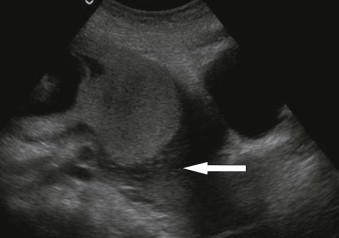
There are pitfalls in assigning the true relationship:
An overfull maternal bladder or a uterine contraction may compress the lower segment of the uterus mimicking an internal os close to the placenta ( Figure 5-5 ).
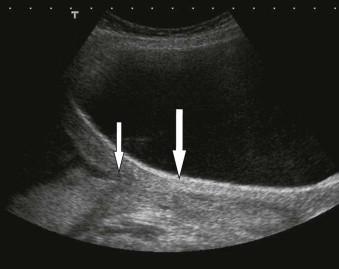
The lower edge of a posterior placenta may be hidden by the fetal head.
Development of the lower uterine segment means that the placenta may not be low-lying by term ( Figure 5-6 A and B ).
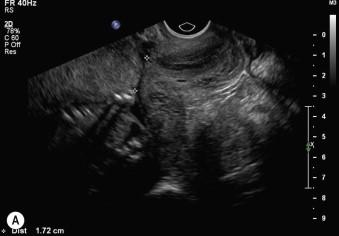
It has been shown that only if the placental edge overlies the internal os by over 2 cm in the second trimester does it predict true praevia at term. Regression analyses for factors associated with resolution of a low-lying placenta by term show that only gestational age and distance from the cervical os at diagnosis are associated with resolution. A total of 98% of apparently marginal (those whose lower edge reached the internal os) placenta praevias resolved at a mean gestational age of 28.6 ± 5.3 weeks, suggesting that a third trimester follow-up ultrasound is not needed for these.
Clinically, suspicion for placenta praevia should be raised in all women with vaginal bleeding regardless of previous imaging. A high presenting part, an abnormal lie and painless or unprovoked bleeding suggest a low-lying placenta and further ultrasound should then be done. Some centres restrict further ultrasound to only those who had a placenta in the lower third of the uterus at the second trimester scan, but this runs the risk of missing an accessory lobe or other abnormality that was occult at the second trimester scan.
Become a Clinical Tree membership for Full access and enjoy Unlimited articles
If you are a member. Log in here